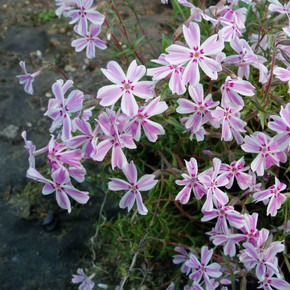
COMING SOON - Phlox nivalis 'Camla' - TRAILING PHLOX - MOSS PHLOX 'CAMLA' (moderate spreading)
Phlox nivalis 'Camla' reminds of finer looking Phlox subulata (Creeping or Moss phlox). Little known, but vigorous plant.
It has shiny, evergreen needle-like leaves and mauve-pinkish, medium-sized flowers. It is very drought and heat tolerant, need well drained or sandy soils. Tough plant with similar needs like creeping phlox. In early spring, the flowers completely cover the whole plants.
Easy to grow perennial, the only need is some sunlight and drainage. Suitable for rock gardens, or edging plant, for dry slopes, as substitute for the lawn in sunny drier soil, sunny areas of woodland gardens, for native plant gardens or naturalizing. Looks very good with rock.
Even this plant is considered "ground covering" plant, it's not highly competitive for true groundcover - it can compete only on sunny and dry spots (other plants can quite easily self-seed, intermingle or even overpower it).
Blooming time : April/May to MaySize : 3-4” tall x 40" wide
USDA zones : 5 to 9
Culture : full sun, half shade, dappled sun, gravelly, rocky, sandy soils, poor and shallow soils, xeriscape. Drainage is essential!
Moisture Needs : dry, medium-dry, soil has to be drained. Prefers more acidic soils than Phlox subulata.
Origin : wild form of Phlox nivalis is native wildflower to eastern USA, Wisconsin, Michigan, Utah and Texas. See the USDA distribution map.
Deer/rabbit resistant : yes / yes
Attracts Butterflies or Pollinators : butterflies
Attracts Hummingbirds : yes
Pot Size : 3.5" perennial pot (1.22 pt/580 ml)
Picture copyright : US Perennials nursery, LLC
Plant combinations : For the edges, along patios and paths, rock gardens, trough gardens, crevice gardens, slopes. Best combined with smaller to medium sized perennial – from native choose shorter Agastache, Anemone patens, Antennaria, Asclepias tuberosa, dwarf Baptisia, Campanula rotundifolia, Coreopsis, Cunila origanoides, Dalea, shorter Echinacea, Gaillardia, Gaura (shorter cultivars), smaller cultivars of Heuchera (in cooler regions), Penstemons, Ruellia humilis, shorter cultivars of Stokesia, Verbena canadensis, native grasses like Boutelloa gracilis, Koeleria cristata, Sporobolus heterolepis 'Tara' (or non-native Sesleria).
And non-native perennials like Achillea, summer blooming Allium, shorter Aquilegia, Armeria, Calamintha, Campanula, Cerastium, Delosperma, Dianthus, Geranium (G. sanquineum, G. dalmaticum and x cantabrigiense, G. cinereum, G. endresii, G. renardii), Gypsohila, Iris (dwarf and miniature bearded Iris), shorter Lavandula, shorter Nepeta, Origanum, shorter Platycodon, Satureja, Salvia, Sedum, Sempervivum, low Stachys,Scabiosa columbaria, Thymus, lower Veronica and many spring bulbs.

COMING SOON - Phlox nivalis 'Camla' - TRAILING PHLOX - MOSS PHLOX 'CAMLA' (moderate spreading)
Phlox nivalis 'Camla' reminds of finer looking Phlox subulata (Creeping or Moss phlox). Little known, but vigorous plant.
It has shiny, evergreen needle-like leaves and mauve-pinkish, medium-sized flowers. It is very drought and heat tolerant, need well drained or sandy soils. Tough plant with similar needs like creeping phlox. In early spring, the flowers completely cover the whole plants.
Easy to grow perennial, the only need is some sunlight and drainage. Suitable for rock gardens, or edging plant, for dry slopes, as substitute for the lawn in sunny drier soil, sunny areas of woodland gardens, for native plant gardens or naturalizing. Looks very good with rock.
Even this plant is considered "ground covering" plant, it's not highly competitive for true groundcover - it can compete only on sunny and dry spots (other plants can quite easily self-seed, intermingle or even overpower it).
Blooming time : April/May to MaySize : 3-4” tall x 40" wide
USDA zones : 5 to 9
Culture : full sun, half shade, dappled sun, gravelly, rocky, sandy soils, poor and shallow soils, xeriscape. Drainage is essential!
Moisture Needs : dry, medium-dry, soil has to be drained. Prefers more acidic soils than Phlox subulata.
Origin : wild form of Phlox nivalis is native wildflower to eastern USA, Wisconsin, Michigan, Utah and Texas. See the USDA distribution map.
Deer/rabbit resistant : yes / yes
Attracts Butterflies or Pollinators : butterflies
Attracts Hummingbirds : yes
Pot Size : 3.5" perennial pot (1.22 pt/580 ml)
Picture copyright : US Perennials nursery, LLC
Plant combinations : For the edges, along patios and paths, rock gardens, trough gardens, crevice gardens, slopes. Best combined with smaller to medium sized perennial – from native choose shorter Agastache, Anemone patens, Antennaria, Asclepias tuberosa, dwarf Baptisia, Campanula rotundifolia, Coreopsis, Cunila origanoides, Dalea, shorter Echinacea, Gaillardia, Gaura (shorter cultivars), smaller cultivars of Heuchera (in cooler regions), Penstemons, Ruellia humilis, shorter cultivars of Stokesia, Verbena canadensis, native grasses like Boutelloa gracilis, Koeleria cristata, Sporobolus heterolepis 'Tara' (or non-native Sesleria).
And non-native perennials like Achillea, summer blooming Allium, shorter Aquilegia, Armeria, Calamintha, Campanula, Cerastium, Delosperma, Dianthus, Geranium (G. sanquineum, G. dalmaticum and x cantabrigiense, G. cinereum, G. endresii, G. renardii), Gypsohila, Iris (dwarf and miniature bearded Iris), shorter Lavandula, shorter Nepeta, Origanum, shorter Platycodon, Satureja, Salvia, Sedum, Sempervivum, low Stachys,Scabiosa columbaria, Thymus, lower Veronica and many spring bulbs.






